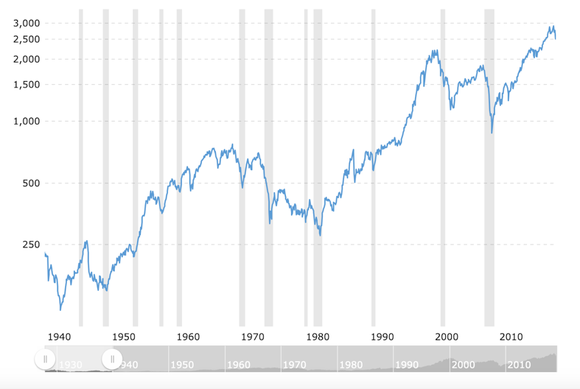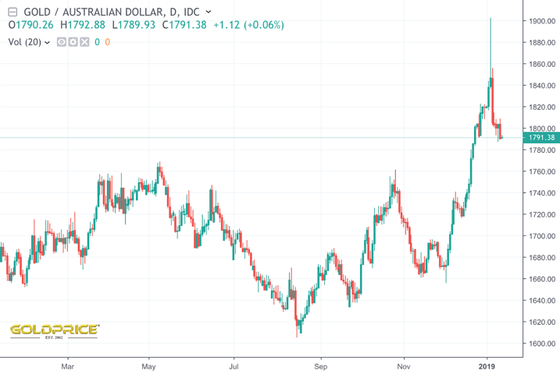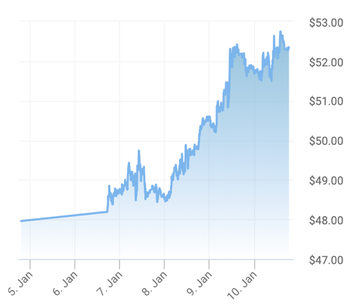Will 2019 see a rebound in stock markets?
Published 11-JAN-2019 14:47 P.M.
|
4 minute read
Hey! Looks like you have stumbled on the section of our website where we have archived articles from our old business model.
In 2019 the original founding team returned to run Next Investors, we changed our business model to only write about stocks we carefully research and are invested in for the long term.
The below articles were written under our previous business model. We have kept these articles online here for your reference.
Our new mission is to build a high performing ASX micro cap investment portfolio and share our research, analysis and investment strategy with our readers.
Click Here to View Latest Articles
When all was said and done, 2018 was a bit of a shocker as far as the stock market goes — on the ASX, the US and beyond.
The year didn’t start out too badly, but with a number of global and domestic negative factors at play, things took a miserable turn in the second half of the year.
Taking a look at the US market, CNN concluded it was the worst year for stocks in 10 years. During the year, the Dow fell 5.6%, the Nasdaq fell 4%, and the S&P/ASX 200 dropped a total of 7.35%.
December was a particularly costly month — apparently, the worst December since 1931. This was topped off by a Christmas Eve which was the DOW’s worst, ever.
With plenty of investors feeling bruised by a shocking 2018, are there reasons to feel optimistic about the year ahead?
Things should turn around, according to history
Taking a look at the last circa 50 years, markets have typically stabilised in the 1-3 years following a big retracement.
Following the GFC in 2008, as a useful if extreme example, the S&P 500 rose 26.5%.
If you take a look at the S&P 500’s five worst quarters since 1970, the years immediately following each saw fairly steep rises:

- The quarter ending September 1974 was down -25.2%; the following three years saw it recover by 72.7%.
- The quarter ending December 1987 was down -22.6%; the following three years saw it recover by 48.8%.
- The quarter ending December 2008 was down -21.9%; the following three years saw it recover by 48.6%.
- The quarter ending June 1962 was down -18.0%; the following three years saw it recover by 69.2%.
- The quarter ending June 1970 was down -18.0%; the following three years saw it recover by 57.4%.
With those stats in mind, history should work in our favour on this one. The problem is that we don’t know for sure where we are in the cycle, and thus we won’t know when the market has hit bottom.
But in terms of the ASX and the US markets, a continuation of 2018’s decline would be unusual, and would represent one of the longest in history.
In the US, presidents’ third years have only been a negative year for the stock market twice before — and the last time was in 1939. For the third year of a president’s term, the S&P 500 has averaged an impressive 17.8%.
Of course, nothing about Trump’s presidency to date has followed any precedent that came before him (not in the US, anyway). The unpredictability and all-round volatility created by his style of leadership has been well-established.
Whether the market will recover regardless of Trump remains to be seen. In 2018, the ‘Trump bump’ had a significant effect on markets, and for the first half of the year it was largely positive. This has been attributed to tax cuts (which boosts companies’ after-tax profits and stock valuations) as well as his deregulation agenda prompting a bullish market.
It’s impossible to know whether the slump (which has been called the ‘Trump slump’) we are currently in will continue or whether the markets will follow well-trodden path of bear markets preceding a sharp rebound.
Weak Australian dollar a plus for ASX gold plays
The Australian dollar has been weakening for some time, dropping to US$0.70 by the end of 2018.
With that, the price of gold (in AU dollars) has been on the rise, and has enjoyed a huge spike to kick off the beginning of 2019. It peaked at $1851.78 an ounce on January 2:

Unsurprisingly, there are ASX gold stocks, big and small, which are benefitting from ideal macroeconomic conditions so far this year.
Small-cap gold miner Ramelius Resources (ASX:RMS) is up ~24% since the year end. Fellow gold small-cap Dacian Gold Ltd (ASX: DCN) is up ~23% in the last month. And the $18 billion-capped Newcrest Mining Ltd NCM:ASX is up a solid ~11% so far in 2019.
It’s oil good, mate?
Another area giving reasons to look on the positive side is the oil price rally that’s surprised everyone so far this year. The West Texas Intermediate (WTI) crude oil — used as a global benchmark — started the year at $45.41 and is now at $52.34:

In response, we’ve seen several small cap oil stocks on the ASX get a bump, including 88E Energy (ASX:88E) which is up 15% for 2019 so far, Red Emperor (ASX:RMP) which is up 26% for the year, and Invictus Energy Ltd (ASX:IVZ) which is up 22% YTD.
A few danger areas
While there’s reason to feel positive about 2019, there’s an equal number of reasons to err on the pessimistic side in regards to the stock market.
In Australia, the deflating housing market is a cause for concern, coupled with the strong possibility of the RBA following the Federal Reserve’s lead in raising interest rates.
With current high levels of household debt, both factors could affect the bounce-back of the stock market, as mortgage holders potentially feel the pinch of higher rates, combined with reduced valuations. Reduced liquidity in the housing market has the added downside of consumers holding less free cash to invest in stocks.
Then there’s the daunting question mark over what (else) Trump is going to do this year. How long will the government shutdown continue? Where will the China trade discussions ultimately end up? Will Trump be impeached, causing even more market-crippling volatility at a global scale?
In Australian politics, we also face the possibility of a change in leadership, with Scott Morrison and the NLP unpopular, according to December 2018 polls which put the Liberals at a 10-point deficit.
Labor’s potential return to the helm could arguably be good for some stocks, particularly those in green energy or sustainability — while the flipside is it would likely be worse for oil and gas stocks, with the possibility of greater climate change-related regulation.
Like the start of every new year, it’s impossible to tell what stock markets will do and how investors will respond to the multitude of complex factors we are set to face in 2019.
But history tells us that even if the downturn continues, there will be winners to be found somewhere in the cycle — it’s just a matter of finding the right opportunities at the right time.
General Information Only
S3 Consortium Pty Ltd (S3, ‘we’, ‘us’, ‘our’) (CAR No. 433913) is a corporate authorised representative of LeMessurier Securities Pty Ltd (AFSL No. 296877). The information contained in this article is general information and is for informational purposes only. Any advice is general advice only. Any advice contained in this article does not constitute personal advice and S3 has not taken into consideration your personal objectives, financial situation or needs. Please seek your own independent professional advice before making any financial investment decision. Those persons acting upon information contained in this article do so entirely at their own risk.
Conflicts of Interest Notice
S3 and its associated entities may hold investments in companies featured in its articles, including through being paid in the securities of the companies we provide commentary on. We disclose the securities held in relation to a particular company that we provide commentary on. Refer to our Disclosure Policy for information on our self-imposed trading blackouts, hold conditions and de-risking (sell conditions) which seek to mitigate against any potential conflicts of interest.
Publication Notice and Disclaimer
The information contained in this article is current as at the publication date. At the time of publishing, the information contained in this article is based on sources which are available in the public domain that we consider to be reliable, and our own analysis of those sources. The views of the author may not reflect the views of the AFSL holder. Any decision by you to purchase securities in the companies featured in this article should be done so after you have sought your own independent professional advice regarding this information and made your own inquiries as to the validity of any information in this article.
Any forward-looking statements contained in this article are not guarantees or predictions of future performance, and involve known and unknown risks, uncertainties and other factors, many of which are beyond our control, and which may cause actual results or performance of companies featured to differ materially from those expressed in the statements contained in this article. S3 cannot and does not give any assurance that the results or performance expressed or implied by any forward-looking statements contained in this article will actually occur and readers are cautioned not to put undue reliance on forward-looking statements.
This article may include references to our past investing performance. Past performance is not a reliable indicator of our future investing performance.
